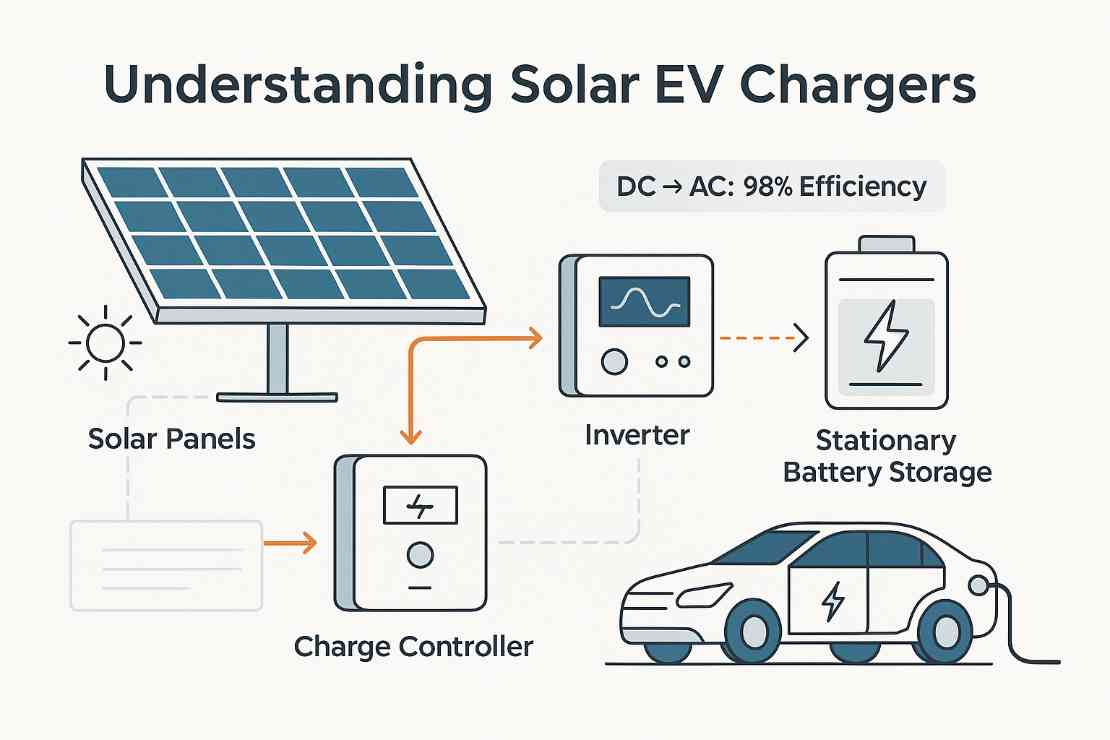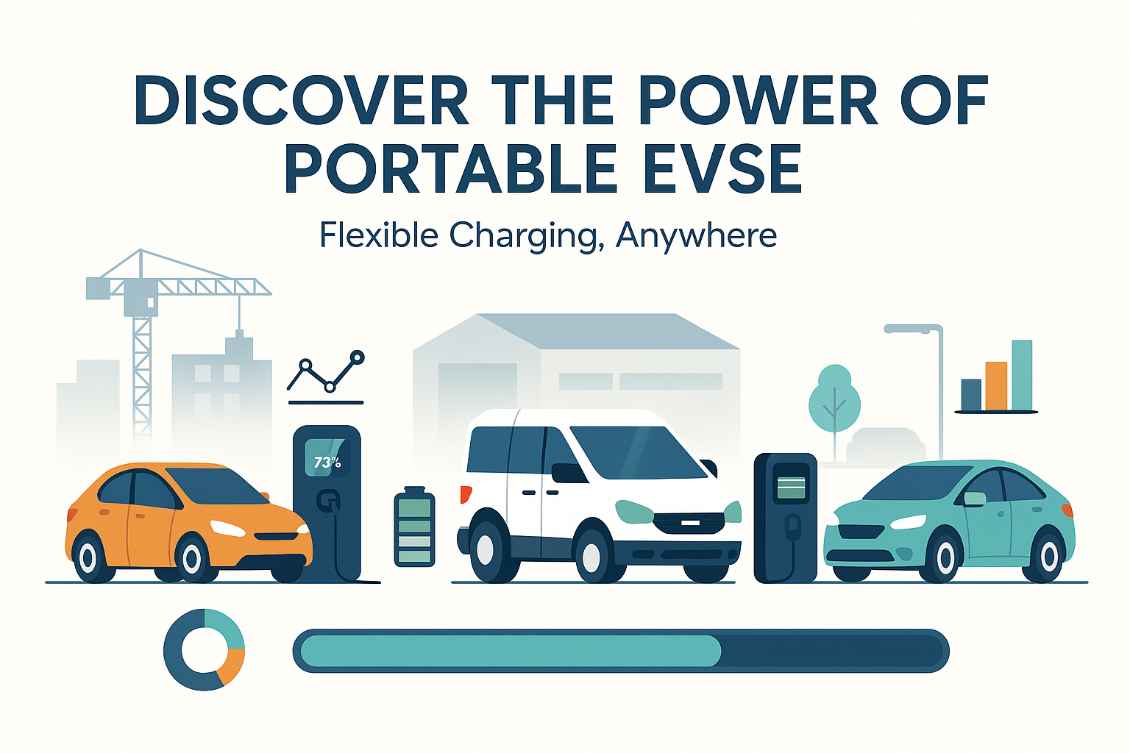Solar electric vehicles already play a central role in decarbonising mobility. Marrying them with photovoltaic generation pushes sustainability—and profitability—even further. This guide unpacks what you need to know about solar EV chargers, from technical building blocks to large-scale roll-outs, so you can future-proof your charging operations while keeping operating expenditure under tight control.
Understanding Solar EV Chargers

How photovoltaic charging works
A solar EV charging station couples a solar PV array with power electronics that turn sunlight into reliable vehicle‐ready electricity. Solar modules produce direct current, inverters convert it to alternating current, and charge controllers regulate the flow so batteries inside the car accept energy at the correct voltage and current. You can bolt on stationary battery storage to capture midday surplus and release it after dark or during grid outages.
The essential hardware
- Solar panels – mono- or polycrystalline modules sized to meet your fleet’s daily kilowatt-hour demand
- Solar inverter – transforms DC from the array into AC for the charger or local grid
- Charge controller – balances charging current, prevents over-voltage and extends battery life
- Optional stationary storage – lithium-ion or second-life EV packs smooth supply, shave peaks and unlock off-grid operation
Why battery storage matters
Without storage, you bank on real-time sun exposure. Add a battery and you create a buffer that absorbs excess generation and guarantees a stable charging profile even when a cloud passes or drivers plug in overnight. Fleets with tight departure schedules gain predictability, and operators can earn extra by exporting unused energy back to the grid where regulations allow.
Common early-stage pitfalls
- Underestimating the capex for panels, mounting and wiring
- Overlooking storage, then fighting midday congestion and evening shortfalls
- Ignoring local irradiance data—300 sunny days per year in India look great on paper, but micro-climates and shading can clip output
Benefits of Solar EV Charging Stations

Cutting reliance on the grid
Solar-integrated charging sites pull far less energy from utility lines, shielding you from tariff hikes and peak-demand penalties. During daylight hours you can run chargers almost entirely on self-generated power. Over a full year, that detachment markedly reduces your electricity bill.
Access where cables struggle to reach
Remote depots and transit routes often face weak grid infrastructure. A containerised solar-plus-storage charger drops straight onto a prepared pad, providing an autonomous energy source without waiting months for a substation upgrade.
Lowering emissions at every stage
Traditional grid electricity frequently contains a fossil-fuel component. Replace it with on-site solar and you slash well-to-wheel greenhouse gases. For operators contracted to sustainability-focused corporates or municipalities, that differentiation can win tenders.
Signalling commitment to ESG
Customers, investors and drivers notice visible panels. A branded canopy shading vehicles while harvesting energy demonstrates tangible progress toward environmental targets—far stronger than slide-deck pledges alone.
Economic Advantages
Solar electricity undercuts bought-in power
Once the array is installed and financed, sunlight costs nothing. Operations boil down to periodic cleaning and an inverter replacement every decade or so. Per-unit energy costs therefore fall well below retail tariffs, especially during mid-afternoon peaks when utilities charge most.
Capital incentives sweeten returns
Governments recognise solar’s role in decarbonisation. In India, for example, supportive policies attracted $3.8 billion of investment into the solar sector over the last three fiscal years. Grants, accelerated depreciation and net-metering all push internal rates of return into attractive territory.
Total cost of EV ownership heads south
Cheaper charging feeds directly into lifetime running costs. For fleet managers measured on cost per kilometre, the saving widens the gap versus combustion vehicles and accelerates payback on the initial EV purchase. You can also calculate savings using this EV charging cost calculator or explore factors that impact charging cost per kWh.
Think lifespan, not just sticker price
A common mistake is focusing solely on panel and inverter capex. Modellers must include twenty-plus years of free generation to see the full picture. When you stack that against fossil-fuel volatility, solar quickly emerges as the fiscally prudent choice.
Technological Innovations

Smart energy management systems (SEMS)
Modern sites incorporate smart charging management software that juggle power flows between the PV array, the stationary battery, plugged-in vehicles and occasionally the building itself. Real-time algorithms prioritise charging when irradiance peaks, delay non-urgent plugs when clouds loom and export surplus to the grid when prices spike.
Second-life battery storage
An Indian automotive manufacturer recently partnered with a battery-recycling start-up to deploy the country’s first off-grid solar charger powered by repurposed EV packs. By giving traction batteries a second life, the station cuts material waste and lowers the cost of stationary storage—a model fleet operators can replicate. Learn more about energy storage systems and their role in EV charging networks.
Rapid deployment micro-stations
Containerised systems ship with panels pre-mounted, inverters wired and batteries racked. Crane them into place and you are energised within days, avoiding complex civil works. This approach proves especially valuable for temporary job-site charging or pilot programmes where you want to test utilisation before committing to permanent infrastructure.
Remote performance analytics
Cloud dashboards monitor generation, consumption and battery state-of-charge. Proactive alerts flag inverter faults or panel soiling, allowing you to dispatch maintenance before downtime bites into service levels.
Implementation and Scalability
Harnessing abundant sunshine
Countries blessed with high irradiance—India counts roughly 300 sunny days each year—can scale solar charging at pace. Even in temperate regions, summer surplus offsets winter deficits when integrated into broader energy portfolios.
Policy frameworks accelerate rollout
Renewable purchase obligations, net-metering rules and low-interest financing packages nudge project economics firmly into the black. Skipping due diligence on such instruments is a missed opportunity many early movers regret.
Leveraging existing charging networks
A nationwide utility in South Asia operates more than 5,500 public charging points and 1.2 lakh home chargers. By retrofitting rooftop solar onto selected hubs, it demonstrates how legacy infrastructure can morph into a greener, more resilient network without starting from scratch.
Modular storage unlocks flexibility
Scalable battery racks let you right-size capacity for today’s utilisation and add more as EV adoption grows. Pairing storage with bidirectional chargers also prepares your depot for vehicle-to-grid services, unlocking future revenue streams.
Case Studies and Collaborations
Off-grid success with repurposed batteries
At a leading technical university campus, an automobile OEM and a clean-tech start-up co-created an off-grid solar charger that runs entirely on second-life EV packs. The live demonstration now fuels campus shuttles while proving circular-economy viability: batteries retire from propulsion duties yet deliver years of stationary service.
Utility-backed public network
A major power company has rolled out the region’s largest EV charging footprint, spanning more than 620 cities. Many sites incorporate rooftop solar, feeding chargers during the day and trimming grid draw at night via on-site storage. The network shows that solar integration scales from individual depots to nationwide operations when backed by a robust asset-management platform.
Collaboration fuels innovation
These projects underscore the value of partnerships—vehicle manufacturers offering battery expertise, energy start-ups delivering agile technology, and utilities providing grid know-how. Fleet operators that plug into similar ecosystems gain faster permitting, sharper cost structures and reputational capital.
Strategic Roadmap for Fleet Operators and CPOs
- Audit your load profile
Quantify daily and seasonal charging demand across depots. Match that against local irradiance data to size your PV array accurately. - Evaluate site constraints
Roof space, ground availability, shading, and structural limits all influence array configuration. Where footprints are small, consider solar carports that double as weather protection. - Model economics thoroughly
Include capex, expected degradation, O&M, policy incentives and potential revenue from exported energy. Cash-flow models should span at least 15 years to capture real value. - Start with a pilot
Deploy a modular system at one high-throughput site. Refine scheduling, maintenance procedures and SEMS settings before rolling out network-wide. - Plan for future technologies
Choose chargers that support bidirectional flow and software platforms ready for dynamic load management. This future-proofs your investment as vehicle-to-grid and tariff-responsive charging mature. - Partner wisely
Join forces with technology providers like Pulse Energy that offer end-to-end design, installation and remote monitoring. Collaborative contracts sharing performance risk can further de-risk your capital outlay.
Frequently Asked Questions
Q1. What is solar EV charger?
A solar EV charger uses electricity generated by photovoltaic panels, usually combined with an inverter and charge controller, to power an electric vehicle. Unlike conventional chargers that rely solely on the grid, it can operate partially or wholly on self-produced renewable energy.
Q2. How much is a solar EV charger?
Costs vary by capacity, but for a commercial fleet expect capital expenditure to start around the price of a mid-range passenger EV once panels, inverters, mounting and any battery storage are included. Incentives and falling module prices continue to narrow that range.
Q3. What is solar EV charger for home?
A home solar charger typically mixes a rooftop array of 3–6 kW with a wall-mounted inverter and an AC charger rated at 7 kW. It lets homeowners top up during daylight, cut electricity bills and insulate against tariff hikes.
Q4. How do I determine the right battery size for my depot?
Analyse your vehicle departure schedule and identify the largest energy draw when the sun isn’t shining. Size stationary storage to cover that gap with a 10–20% buffer for degradation and unexpected demand spikes.
Q5. Does solar charging deliver the same performance as grid charging?
Yes. Once the inverter converts DC from the panels or battery to AC, the charger delivers identical voltage and current as a grid-fed unit. Smart systems even prioritise solar when available, seamlessly switching to grid backup when necessary.
Q6. What should I check first if my solar charger suddenly slows down?
Look at real-time data from the SEMS. Reduced solar output could stem from panel soiling, shading or an inverter fault. If solar generation is normal, confirm the charge controller’s settings and ensure the vehicle itself is not limiting current.
For more insights on optimizing your solar EV charging experience and to explore our innovative charging software solutions, visit us at pulseenergy.io. We're here to help you make the most of your solar power!





.jpg)
.jpg)

